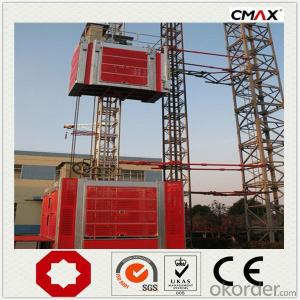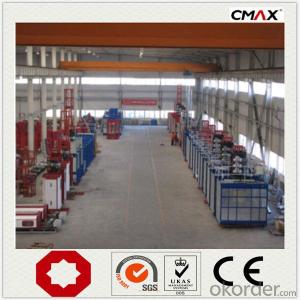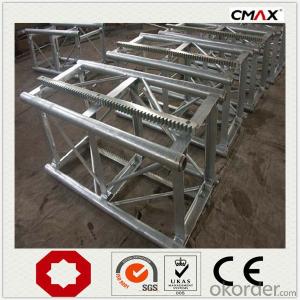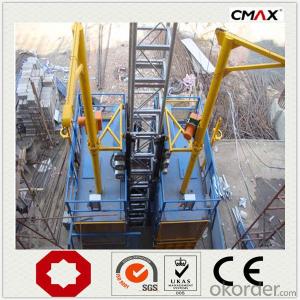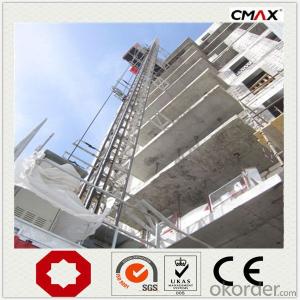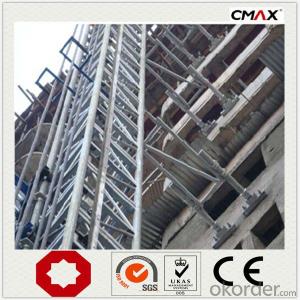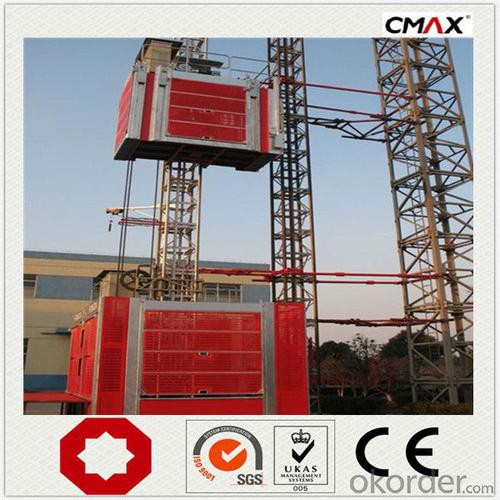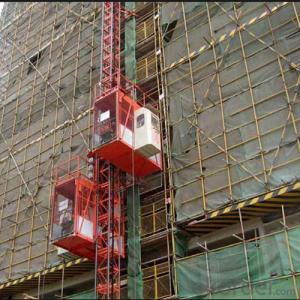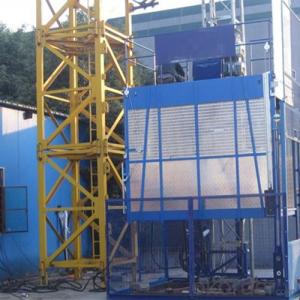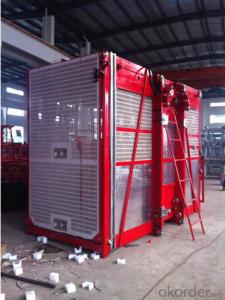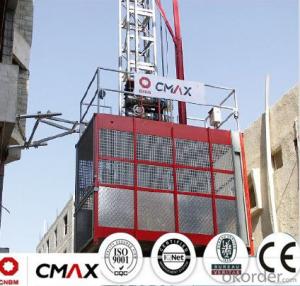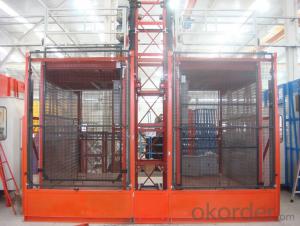Construction Hoist 33m/min Lifting Speed
- Loading Port:
- China main port
- Payment Terms:
- TT OR LC
- Min Order Qty:
- 1 unit
- Supply Capability:
- 100 unit/month
OKorder Service Pledge
OKorder Financial Service
You Might Also Like
Structure of Construction Hoist Description
The general building hoist manufactured by our company have the features as good quality, long life, wide application range and convenient for maintenance. The gearing adopted bearing,enameled cable, and oil seal. The electric parts adopt products from worl renowned manufacturers such as Schneider, Siemes, and LG. The racks and pinion adopts specal material and heat-treatment technique, which prolong the life of these parts. The surface of the structure can apply paint-spray, parkerizing baking finish or hot galvanizing processing according to users requirments. The cage can be produced and decorated by aluminum molded board, punched-plate or figured aluminum board.
Main Features of Construction Hoist
1. The recomended cage dimension(L*W*H)(m): 2.0*1.0*2.5, 2.5*1.0*2.5, 2.5*1.3*2.5, 3.0*1.5*2,5, 3.2*1.5*2.5, 3.8*1.5*2.5, 4.0*1.5*2.5, 4.2*1.5*2.5 etc. We can also manufacture cages of other size according to the user.
2. The cage and the door material can be aluminum molded board, punched-plate, figured aluminum board or other type according to yout requirements.
3. The mast section and the tie-in surface can adopt paint-spray, or hot galvanizing processing..
Construction Hoist Specifiction
SC series product also has special design, such as reinforced guide rail with cross-section of 800mm, inclined type, special for cooling tower, etc. All the double cage building hoist can be changed into single cage type,
| Type | Payload(kg) | Lifting Speed (m/min) | Motor Power(kw) | Safety Device | ||
| Twin Cage Hoist | No Counterweight | SC100/100 | 2*1000 | 33 | 2*2*11 | 2*SAJ30-1.2 |
| SC120/120 | 2*1200 | 33 | 2*2*11 | 2*SAJ30-1.2 | ||
| SC160/160 | 2*1600 | 33 | 2*2*11 | 2*SAJ30-1.2 | ||
| SC200/200 | 2*2000 | 33 | 2*3*11 | 2*SAJ40-1.2 | ||
| SC250/250 | 2*2500 | 33 | 2*3*11 | 2*SAJ50-1.2 | ||
| SC270/270 | 2*2700 | 33 | 2*3*15 | 2*SAJ50-1.2 | ||
| SC300/300 | 2*3000 | 33 | 2*3*15 | 2*SAJ50-1.2 | ||
| SC320/320 | 2*3200 | 33 | 2*3*15 | 2*SAJ50-1.2 | ||
| With Counterweight | SCD200/200 | 2*2000 | 33 | 2*2*11 | 2*SAJ40-1.2 | |
| SCD250/250 | 2*2500 | 33 | 2*2*11 | 2*SAJ50-1.2 | ||
| SCD270/270 | 2*2700 | 33 | 2*2*15 | 2*SAJ50-1.2 | ||
| SCD300/300 | 2*3000 | 33 | 2*2*15 | 2*SAJ50-1.2 | ||
| SCD320/320 | 2*3200 | 33 | 2*2*15 | 2*SAJ50-1.2 |
Images of Construction Hoist
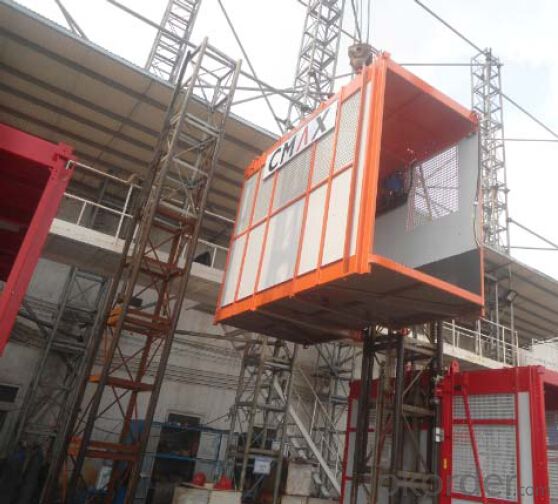
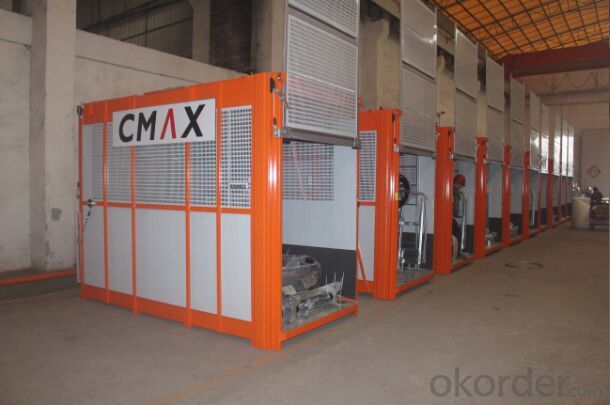
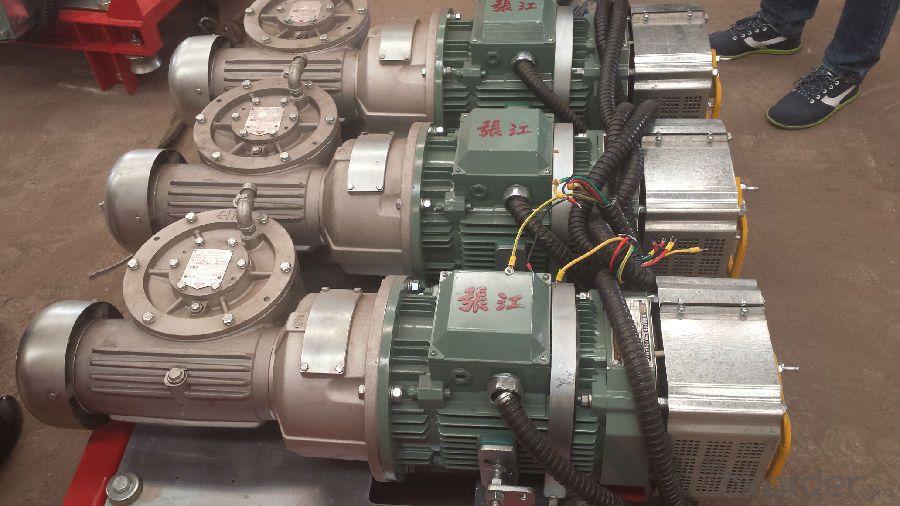
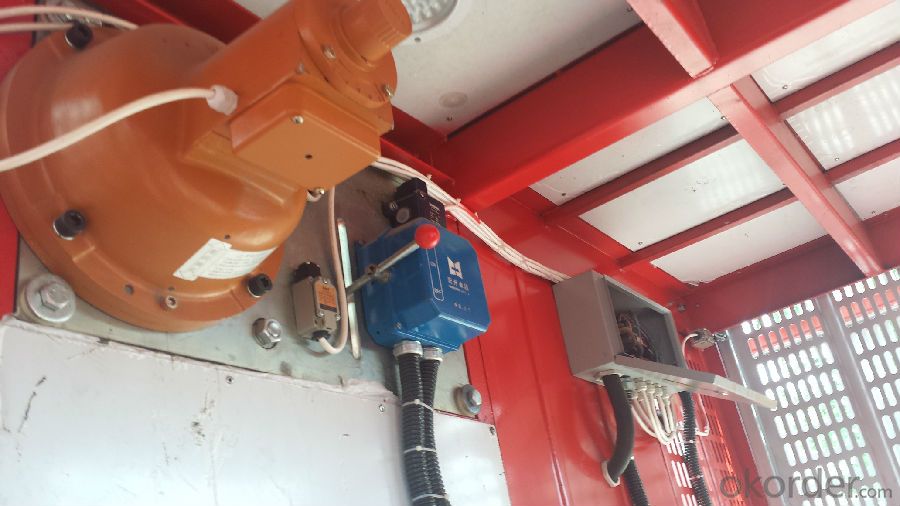
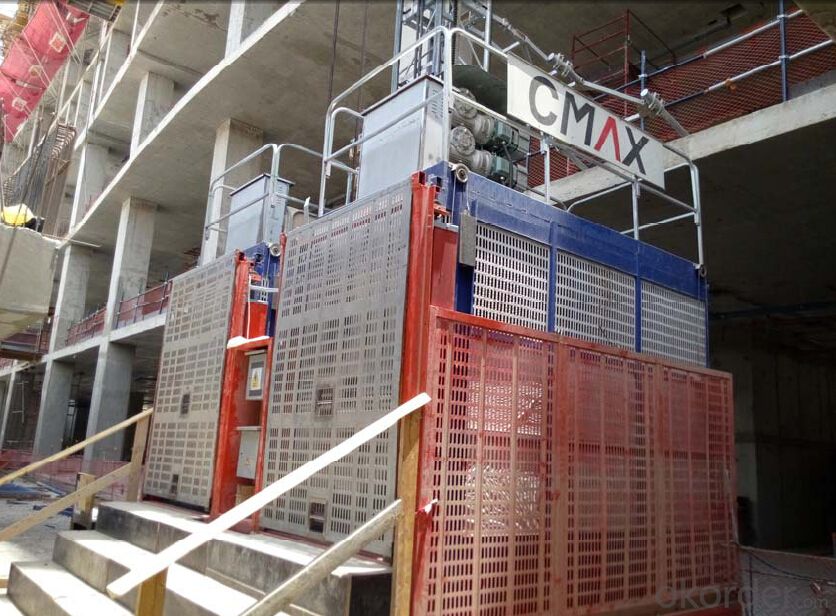
FAQ of Construction Hoist
Q: What is the building hoist main purpose?
A: Building hoist equipped with double or single cabin to transport the materials and labors up and down. It's the ideal
construction equipment for vertical transportation in the field of construction.
Q: What is the main structure of building hoist?
A: The P/M construction hoist mainly contains metal structure, driving system, electrical control system, cable guide & protection system, electrical top crane and safety device.
Q: What is the meaning of the building hoist’s code?
A: Take SC200/200 for example: “SC” stands for rack and pinion hoist, “200/200” stands for double cage and capacity is 2 tons per cage. “SC200” stands for single cage and capacity is 2 tons.
Q: What is the dimension of the cage?
A: Normally the cage dimension is 3X1.5X2.5M (L/W/H) for 2t type hoist. Details should be checked according to our quotation sheet. Also, the size can be customized according to the factual site condition. There are two doors (entrance& exit doors) for each cage, It can be produced as up & down sliding or ramping model for safety and convenience.
- Q: Is it possible to use a building hoist for material transportation in both indoor and outdoor environments, especially in confined spaces within industrial zones?
- <p>Yes, building hoists can be used both indoors and outdoors in industrial areas, even with limited space. They are designed for material transportation during construction and are adaptable to various environments. For indoor use, hoists are often enclosed to protect from weather and debris. Outdoors, they may require additional weatherproofing. In confined spaces, compact and tower hoists are used to save space. However, safety regulations and space constraints must be considered to ensure proper installation and operation.</p>
- Q: Is it possible to use a building hoist for lifting fragile or delicate items?
- <p>A building hoist is generally designed for heavy construction materials and not for delicate objects. However, with the right attachments and careful operation, it can be adapted for lifting delicate items. It's crucial to ensure the hoist is equipped with appropriate stabilizers and cushioning to prevent damage. Always follow safety guidelines and consult with the manufacturer or a professional to determine if the hoist can be safely used for such purposes.</p>
- Q: This question asks about the typical issues that can arise with building hoists, which are mechanical devices used in construction to lift materials and workers.
- <p>Common problems with building hoists include mechanical failures such as broken cables or chains, malfunctioning brakes, and worn-out gears. Electrical issues like short circuits or damaged control panels can also occur. Safety hazards may arise from improper installation or maintenance, leading to accidents. Overloading the hoist can cause structural damage and failure. Environmental factors like extreme weather conditions can affect performance and longevity. Regular inspections and maintenance are crucial to prevent these problems and ensure the safe operation of building hoists.</p>
- Q: This question asks for an identification of the various types of lifting equipment that are specifically utilized in the context of building hoists.
- <p>Different types of lifting equipment used for building hoists include: 1. Electric Chain Hoists, which are versatile and suitable for various lifting tasks. 2. Manual Chain Hoists, that require manual operation and are used for lighter loads. 3. Electric Wire Rope Hoists, known for their high lifting capacity and durability. 4. Air Hoists, which are powered by compressed air and are ideal for environments where electricity is hazardous. 5. Geared Winches, used for pulling or lifting heavy loads with precision. 6. Jib Cranes, which provide a fixed or semi-fixed lifting solution in workshops. 7. Gantry Cranes, used for lifting heavy loads over a specific area. Each type serves specific purposes and is chosen based on the weight, environment, and specific requirements of the construction project.</p>
- Q: This question inquires about the cost of a hydraulic building hoist.
- <p>The cost of a hydraulic building hoist can vary significantly depending on factors such as capacity, brand, features, and new or used condition. Prices typically range from a few thousand dollars for smaller, basic models to tens of thousands for larger, more advanced units. For a precise quote, it's best to contact manufacturers or suppliers with specific requirements, as costs can fluctuate based on the model and market conditions. It's also advisable to consider ongoing maintenance and operational costs when budgeting for a hydraulic building hoist.</p>
- Q: This question asks whether a building hoist can be utilized in both indoor and outdoor environments.
- <p>A building hoist can indeed be used both indoors and outdoors, depending on the specific model and design. Outdoor hoists are typically built to withstand weather conditions and are more robust, while indoor hoists are designed for controlled environments. It's crucial to ensure that the hoist is suitable for the intended environment to maintain safety and functionality. Always follow the manufacturer's guidelines and safety regulations when using a building hoist in any setting.</p>
- Q: This question asks for safety precautions that should be taken when using a building hoist, which is a type of lifting equipment used in construction.
- <p>Safety measures for using a building hoist include regular inspections and maintenance, ensuring all safety devices are in good working order, securing all loads properly, and not overloading the hoist. Operators must be trained and certified. Protective barriers should be in place to prevent unauthorized access. Emergency stop switches should be readily accessible. Workers should wear appropriate personal protective equipment, and communication between the hoist operator and those on the ground should be clear and effective. Adhering to these measures helps prevent accidents and ensures the safe operation of the building hoist.</p>
- Q: What is the highest weight a building hoist can safely lift?
- <p>The maximum load capacity of a building hoist can vary significantly depending on the specific model and design. Generally, capacities range from 500 kg to 3,000 kg or more. It's crucial to refer to the manufacturer's specifications for the exact load capacity of any given hoist. Overloading a hoist can lead to accidents and damage, so it's essential to operate within the specified limits.</p>
- Q: Identify the elements that influence the durability and operational lifespan of lifting machinery, specifically focusing on Building Hoists.
- <p>The lifespan of lifting equipment, including Building Hoists, is influenced by several factors: 1) Material Quality: The type and quality of materials used in construction directly affect durability and resistance to wear and tear. 2) Design and Engineering: Proper design ensures optimal performance and reduces stress on components. 3) Frequency of Use: More frequent use can lead to faster wear and tear. 4) Maintenance and Repair: Regular maintenance can extend the lifespan, while neglect can shorten it. 5) Operating Conditions: Environmental factors such as temperature, humidity, and exposure to corrosive substances can impact longevity. 6) Load Capacity: Overloading can cause premature failure. 7) Compliance with Safety Standards: Adhering to safety guidelines can prevent accidents and damage. 8) Technological Advancements: Newer models may have improved features that extend lifespan.</p>
- Q: Is it possible to use a building hoist for lifting heavy materials that cannot be manually lifted?
- <p>Yes, a building hoist is specifically designed for lifting heavy materials that are too heavy or cumbersome to lift manually. These hoists are engineered to handle significant weight loads and are commonly used in construction settings to move materials such as bricks, cement, and steel beams to various levels of a building. They are an essential tool for safe and efficient material handling in construction projects.</p>
Send your message to us
Construction Hoist 33m/min Lifting Speed
- Loading Port:
- China main port
- Payment Terms:
- TT OR LC
- Min Order Qty:
- 1 unit
- Supply Capability:
- 100 unit/month
OKorder Service Pledge
OKorder Financial Service
Similar products
Hot products
Hot Searches
Related keywords
